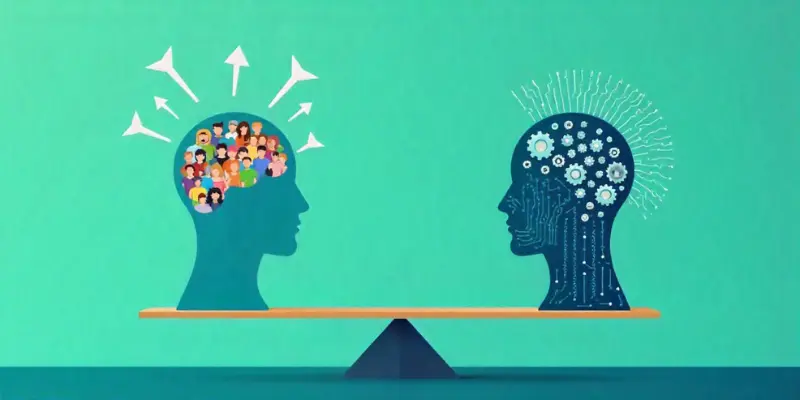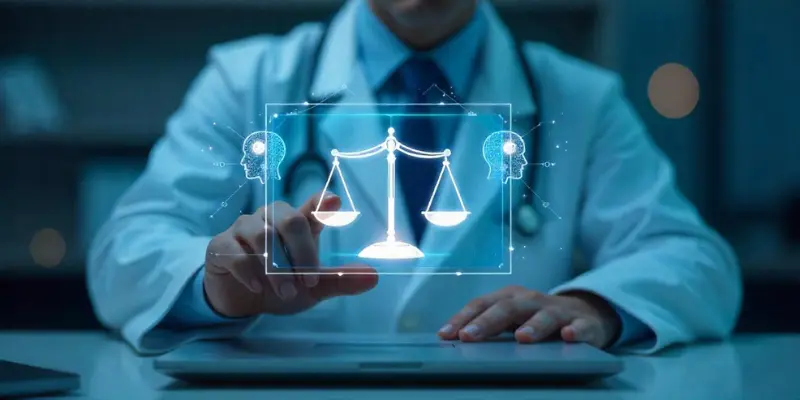Problems With AI in Healthcare and How We Can Make It Work
Published: 8 Mar 2025
Imagine a smart computer that spots a lung problem on an X-ray before a doctor even looks at it. Sounds exciting, right? Artificial intelligence fancy words for computers that learn from data — promises this kind of speed and accuracy. But what happens if the computer misses a detail or makes a choice that harms certain patients?
In this post, we’ll look at two things:
- The main problems with AI in healthcare — bias, privacy risks, “black-box” decisions and more.
- Simple ways to fix those problems so doctors, hospitals and patients can trust AI tools.
By the end, you’ll know why AI isn’t magic, why it still needs careful human checks and what steps can make it safe for everyone. Ready to dive in?

What Is AI in Healthcare?
AI stands for Artificial Intelligence. That means smart computer systems that learn from data and make decisions just like humans but faster. In healthcare, AI helps doctors and nurses in many ways. It doesn’t replace them but it supports them.
Where AI Is Used in Healthcare
Here are some easy-to-understand examples:
- Reading Medical Scans:
AI can look at X-rays, MRIs and CT scans to find signs of diseases like cancer or pneumonia. - Chatbots for Mental Health:
Some apps talk with people who feel sad or stressed and give simple advice. - Predicting Patient Risk:
AI can look at health records and warn doctors if someone might get sick soon. - Keeping Hospital Records Organized:
AI tools help sort and store patient data faster than humans.
Why It’s Popular
Doctors are busy. Hospitals need fast answers. AI can help save time and reduce mistakes but only if used correctly.
The Big Problems With AI in Healthcare
AI is transforming healthcare, but it’s not without challenges. From misdiagnoses to data privacy concerns AI’s rapid adoption is raising serious questions. Let’s explore the biggest problems of AI in healthcare and how they impact patients, doctors and medical institutions.
Here’s is a list of challenges that healthcare professionals and patients face while using AI in healthcare;
- Accuracy and Reliability Issues
- Bias in AI Algorithms
- Data Privacy and Security Risks
- Ethical and Legal Challenges
- Lack of Transparency (Black Box Problem)
Let’s break down each problem in detail.
Problem 1: Accuracy and Reliability Issues
AI is helping doctors diagnose diseases, read medical images, and predict health risks faster than ever before. But just because it’s fast doesn’t mean it’s always right. Sometimes, the AI makes mistakes that can seriously affect a patient’s health. One small error in the system or bad data can lead to wrong decisions. And in healthcare, a wrong decision can be dangerous.
- AI can learn from biased data. If the data mostly includes young patients, it may not give good results for older people.
- It struggles with rare diseases because it hasn’t seen enough examples to learn from.
- If AI is trained on mistakes from the past, it may think those mistakes are normal.
- As medicine changes, AI may keep using old knowledge unless it’s updated regularly.
- AI doesn’t always understand the full story, like a patient’s symptoms, feelings, or background.
Real-life example: In 2019, a hospital used an AI tool to detect diabetic eye disease. During testing, it worked well. But in real clinics, poor lighting and blurry images confused it. It failed to catch serious cases, and about 20% of patients got wrong results. Doctors had to stop using it and retrain the system with better, clearer data.
Problem 2: Bias in AI Algorithms

AI is designed to help doctors make better decisions but sometimes it quietly picks favorites. That happens when the system learns from data that only tells one side of the story. If most of the examples it sees come from a certain group like younger patients or people with lighter skin it may not understand how to treat older patients or people with dark skin respectively. This can lead to unfair results and poor care for those left out.
- AI models may give wrong diagnoses if they’re trained mostly on data from one race or age group.
- Patients from rural or underdeveloped areas may get inaccurate results if the AI only learned from big-city hospital data.
- Some tools might not spot signs of illness in women if they were trained mostly on male patients.
- Bias can sneak in during data labeling, especially if human reviewers add their own assumptions.
- Even small missing details like income level or language can cause the AI to treat some patients as “less important.”
Real-life example: One major study showed that AI skin cancer tools worked best on white patients because the images used to train the system mostly showed lighter skin. This meant people with darker skin had a higher chance of getting the wrong results, leading to delayed or incorrect treatment.
Problem 3: Privacy and Security Risks
AI tools in healthcare need a lot of personal data to work properly. This includes medical history, lab results and even daily habits. While this helps the AI give better suggestions, it also creates big risks. If this private information isn’t kept safe, it can fall into the wrong hands. And once patient data is stolen or misused, it’s nearly impossible to undo the damage.
- Hackers target AI systems in hospitals because they store sensitive and valuable patient data.
- A single cyberattack can leak thousands of health records, putting patients at risk of identity theft.
- Some hospitals may use patient data in AI tools without asking for clear permission.
- There’s often no easy way for patients to know how their data is being used or who’s using it.
- Data sharing with third-party companies can happen secretly, raising serious ethical concerns.
Real-life example: In February 2025, a major IVF clinic in Australia, Genea, was hit by a cyberattack. Hackers broke into their systems, disrupted ongoing IVF treatments and stole nearly a terabyte of sensitive patient data. This breach affected thousands of families and raised serious questions about how medical data should be protected in AI-powered systems.
Also Read: Should AI bed used in Healthcare?
Problem 4: Ethical and Legal Challenges

AI is helping hospitals work faster, make smarter decisions and even save lives. But as helpful as it is, AI also brings tricky questions. What happens if the AI makes a bad call? Who gets the blame? And are patients always told how their data is being used? These are big concerns because trust, honesty and safety are the heart of healthcare and AI still has a lot of catching up to do.
- If an AI makes a wrong decision, it’s unclear whether the doctor, hospital or tech company is responsible.
- There are no clear rules in many countries about who owns the decisions made by AI.
- AI can sometimes make choices that don’t match human values or medical ethics.
- Many tools use patient data without asking for clear or full consent.
- Patients are often unaware their data is being shared with outside AI companies.
Real-life example: One hospital used an AI tool to sort patients by urgency in the emergency room. The AI wrongly delayed treatment for several people with serious conditions. When families demanded answers, no one could say who was at fault—the doctor, the hospital or the AI team. This situation showed how confusing and risky things can get when there are no strong legal rules for AI in healthcare.
Problem 5: Lack of Transparency (Black Box Problem)
AI tools in healthcare often work like a “black box”—they give answers but don’t show how they got there. This makes it hard for doctors to understand why the AI suggested a certain diagnosis or treatment. If no one can explain how the AI reached a decision, it becomes difficult to trust, question or fix the result. In healthcare, every step matters. When something goes wrong, doctors need clear answers not mystery math.
- Many AI tools don’t show the reasoning behind their decisions.
- Doctors may hesitate to use AI if they can’t explain it to patients.
- Mistakes are harder to catch if no one understands the process behind them.
- Lack of transparency makes it tough to improve or correct the AI system.
- Patients may feel uneasy when machines decide their care without clear reasons.
Real-life example: A hospital used an AI system to decide which patients should be admitted to the ICU. One patient with serious symptoms was marked as “low risk.” When doctors questioned the result, they couldn’t figure out how the AI made the choice. The model had no explanation feature. The delay in ICU admission affected the patient’s recovery and showed why explainable AI is so important in medical care.
How We Can Make AI in Healthcare Work Better
AI has big potential in healthcare, but to use it safely and fairly, we need to make some smart changes. It’s not about stopping AI, it’s about using it the right way. Here’s how we can fix the problems and build better trust in AI tools.
Use Better and Fair Data
AI needs to learn from all kinds of people not just one group. That means using medical data from different ages, skin colors, genders and backgrounds.
- This helps the AI treat everyone fairly.
- It reduces bias and avoids wrong results.
- More variety = more accurate outcomes for everyone.
Make AI Explain Its Decisions
Doctors and patients should know why the AI suggested something. If AI says “This patient is at risk,” there should be a reason.
- It builds trust.
- It helps doctors check and correct mistakes.
- It protects patients from blind decisions.
Keep Patient Data Safe
Patient records are private. AI tools must protect that data at all costs. A leak can harm trust and break laws.
Tips:
- Use strong passwords in all systems.
- Encrypt data so hackers can’t read it.
- Follow privacy laws like HIPAA (it’s a rule that keeps patient info safe in hospitals).
Train Doctors to Work With AI
Doctors are smart but AI is new. They need the right training to use it safely. Participating in healthcare AI conferences or taking online healthcare AI courses can help professionals to get command in this rapidly developing field.
- It helps doctors know when to trust AI and when not to.
- It builds a strong partnership between humans and machines.
- It lowers the chance of overdependence.
Make AI Affordable and Accessible
AI shouldn’t be only for big hospitals. Even small clinics should get the chance to use it. Government should fund Healthcare sector to hire AI developers for affordable options.
- It helps rural and low-income areas.
- It reduces the healthcare gap.
- It improves care everywhere not just in rich cities.
Keeping Up With AI Problems: Real-Life Case Study
In Chennai, India, a hospital teamed up with an AI tool called Genki to detect tuberculosis (TB) in remote villages. They used mobile vans equipped with X‑ray machines and took chest images of people in underserved areas. The AI tool labeled each scan as “TB suggestive” or “not TB suggestive.” Doctors then confirmed these results with sputum tests.
- Numbers matter: They screened 25,598 people in 2022.
- High accuracy: Genki had 98 % sensitivity (it identified true TB cases) and 96.9 % specificity (it correctly ruled out non-TB cases).
- Trusted across groups: It performed well for all ages and both men and women .
- Saved time and money: Using mobile AI reduced heavy work for doctors and sped up TB detection in low-resource areas.
- Made it real: The tool worked only because doctors double-checked every AI result and followed up with lab tests.
This project shows how AI needs strong support from human experts to succeed. With good data, smart tools, and human guidance, tools like Genki can help bring fast, accurate, and fair healthcare to places that need it most.
Conclusion
AI is helping us in healthcare but it’s not always perfect. Bias, privacy risks and ethical concerns must be addressed to ensure safe and fair AI adoption. Doctors, hospitals and developers must work together to improve AI systems and reduce risks. Relying too much on AI without human oversight can lead to dangerous mistakes. Always keep active doctors to review AI recommendations before making any medical decision. Patient data must also be handled carefully to prevent privacy breaches.
💡 Final Advice: AI should be a helping tool, not a decision-maker. The best approach is to use AI alongside human expertise for safer and more reliable healthcare solutions.
FAQs About Problems with AI in Healthcare
Here are frequently asked questions about problems with AI in healthcare.
AI helps doctors diagnose diseases, predict risks and improve treatments. Even with challenges AI saves time and improves accuracy in many cases. The goal is to fix these issues and make AI safer for healthcare.
Yes, AI can misdiagnose conditions if trained on biased or incomplete data. That’s why doctors must double-check AI recommendations before making final decisions. AI should be a support tool, not a replacement for medical experts.
AI tools process huge amounts of patient data, making security a big concern. If not properly protected hackers can steal or misuse this information. Strong cybersecurity measures are needed to keep patient data safe.
Many doctors trust their experience over AI recommendations. Others worry AI could replace human jobs or lead to errors in patient care. Proper training and proving AI’s reliability can help doctors feel more comfortable using it.
If used poorly, AI can make healthcare feel less personal. Patients want human connection and empathy, not just AI-driven decisions.
Developing and maintaining AI systems requires advanced technology, skilled experts and large datasets. Many hospitals, especially small clinics, struggle with the high costs of AI. Cheaper cloud-based AI solutions may help make AI more affordable.
Yes, if AI is trained on limited or unbalanced data, it can favor one group over another. This can lead to wrong diagnoses or unfair treatment plans. More diverse and high-quality data can help reduce AI bias.
One major issue is who is responsible if AI makes a mistake. Should blame go to the doctor, hospital or AI developers? There are no clear legal rules yet making AI accountability is a big concern.
No, AI will always need human supervision to make safe and ethical decisions. AI can help doctors but it can’t replace human judgment, experience and empathy. The future is about AI-doctor collaboration, not replacement.
Hospitals and developers must follow strict ethical guidelines to avoid mistakes and biases. Patients should be informed about how AI is used in their treatment. Most importantly, AI should always have human oversight to prevent errors.





